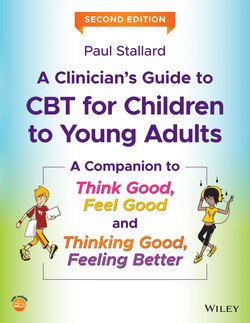Читать книгу A Clinician's Guide to CBT for Children to Young Adults - Paul Stallard - Страница 20
Assessing competence
ОглавлениеA clear strength of CBT is the underpinning philosophy and theoretical model. The philosophy underpins the collaborative process of self‐discovery whilst the theoretical model informs and guides the use of specific techniques. It is therefore important to develop a good understanding of the basic model and to ensure that the process and rationale for use of specific techniques is understood and competently executed.
The most widely used tool for measuring CBT competence with adults is the Cognitive Therapy Scale–Revised (CTS‐R) (Blackburn et al. 2001). This is a revised version of the original Cognitive Therapy Scale developed by Young and Beck (1988). The CTS‐R consists of 12 items which assess important generic CBT skills. These include four general skills (feedback; collaboration; pacing and efficient use of time; and interpersonal effectiveness) and seven specific CBT skills (eliciting appropriate emotional expression; eliciting key cognitions; eliciting behaviours; guided discovery; conceptual integration; application of change methods; and homework setting). The remaining item, agenda setting, overlaps both sets of items and is included in the general and specific sub‐scales.
The suitability of the CTS‐R to assess competencies when using CBT with children and adolescents has been questioned (Fuggle et al. 2012). In particular, the authors argue that the CTS‐R is not appropriate because:
Important systemic influences on the onset and maintenance of the young person’s problems need to be acknowledged and the role of the carers/family in CBT considered.
The young person’s cognitive, emotional, linguistic, and reasoning ability are developing, and CBT needs to be appropriately adapted to be consistent with their abilities.
Creative non‐verbal methods may be required to convey the concepts of CBT to young people in clear and understandable ways.
The process of undertaking CBT with young people and their carers needs greater specification.
Specific CBT competence scales for use with children and young people have been developed and evaluated. Of those available, the majority assess competence in delivering a specific manualised programme or treatments for specific disorders. For example, Mcleod et al. (2019) developed a scale to assess competence delivering the Coping Cat anxiety programme, Bjaastad et al. (2016) the FRIENDS anxiety programme, and Gutermann et al. (2015) for assessing competence in treating PTSD. Although there are some differences in the competencies that have been identified, there are several shared dimensions. For instance, in a Delphi study, Sburlati et al. (2011) identified various generic therapeutic competencies (e.g. practising professionally, knowledge of children and adolescents, building a positive relationship, conducting a thorough assessment), CBT‐specific competencies (e.g. understanding CBT theory, developing a CBT formulation, working collaboratively), and specific CBT techniques (e.g. managing negative thoughts, changing maladaptive behaviours, managing maladaptive mood). McLeod et al. 2018 identified four categories of competence for delivering anxiety interventions. These are interventions that are common to CBT programmes (e.g. maintaining focus on CBT model, homework review, etc.), interventions specific to anxiety programmes (e.g. relaxation, fear ladder, exposure), how the intervention is delivered (coaching, modelling, rehearsal), and overall ratings of skilfulness and responsiveness. Whilst there are some specific differences, there tends to be a consensus that undertaking CBT with children and young people requires competencies both in the method of delivery (e.g. the therapeutic process) and in the application of specific CBT techniques.
